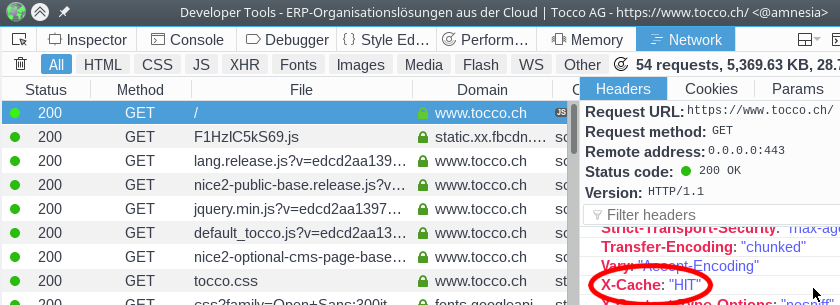This is an internal documentation. There is a good chance you’re looking for something else. See Disclaimer.
Nginx Caching
What data is cached?
Nginx uses the Cache-Control, Expires and Pragma headers (in that order) to determine if and for how long a
resource may be cached.
The HTTP/1.1 standard pretty clearly explains when an entry may be cached. Our setup adheres to this standard.
How do I see if a resource was cached by Nginx?
Search for the X-Cache header on the response. (See screenshot below.)
You’ll usually see one of these values [1]:
Value |
Description |
|---|---|
HIT |
Content has been served from cache. |
MISS |
Content has not been served from cache. |
REVALIDATED |
Content has been served from cache after revalidating with Nice. Nice returned code 304 — not modified — as result of If-Modified-Since or If-Match being included in the request. |

Network tab in Inspector
Bypassing Cache
Curl can be used to bypass the cache and fetch a resource from Nice directly.
Example fetching https://www.tocco.ch/example from Nice2 directly:
oc project ${PROJECT}
oc exec -c nginx dc/nice -- curl -vSL -H 'Host: www.tocco.ch' -H 'X-Forwarded-Proto: https' http://localhost:8080/example
Nice is reachable at localhost:8080 while Nginx is on localhost:8081.
HTTP requests are redirected to their HTTPS equivalent by OpenShift and Nginx will never see such requests.
View Cached Resource
Cache is stored in /var/cache/nginx/proxy_cache. You can use grep to find the cache item belonging to https://www.tocco.ch/example like this:
oc project ${PROJECT}
# Note the omission of '//'
oc exec -c nginx dc/nice -- grep -Pr 'https:www.tocco.ch/example'
Fetch cache file:
oc exec -c nginx dc/nice -- cat ${PATH}
Footnotes